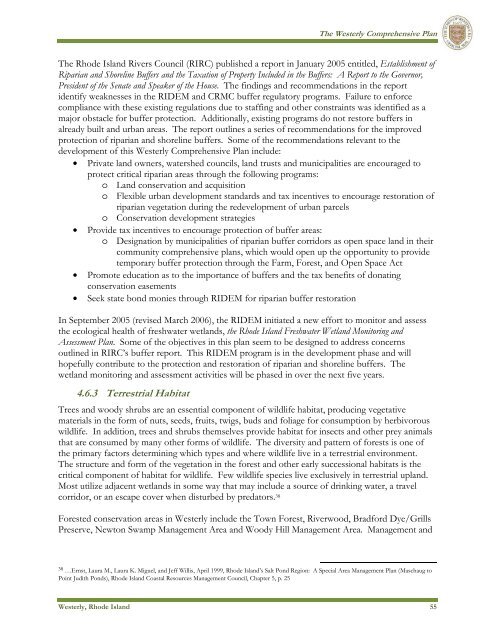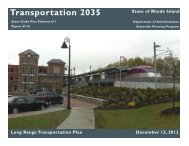Westerly - State of Rhode Island: Division of Planning
Westerly - State of Rhode Island: Division of Planning
Westerly - State of Rhode Island: Division of Planning
Create successful ePaper yourself
Turn your PDF publications into a flip-book with our unique Google optimized e-Paper software.
The <strong>Westerly</strong> Comprehensive PlanThe <strong>Rhode</strong> <strong>Island</strong> Rivers Council (RIRC) published a report in January 2005 entitled, Establishment <strong>of</strong>Riparian and Shoreline Buffers and the Taxation <strong>of</strong> Property Included in the Buffers: A Report to the Governor,President <strong>of</strong> the Senate and Speaker <strong>of</strong> the House. The findings and recommendations in the reportidentify weaknesses in the RIDEM and CRMC buffer regulatory programs. Failure to enforcecompliance with these existing regulations due to staffing and other constraints was identified as amajor obstacle for buffer protection. Additionally, existing programs do not restore buffers inalready built and urban areas. The report outlines a series <strong>of</strong> recommendations for the improvedprotection <strong>of</strong> riparian and shoreline buffers. Some <strong>of</strong> the recommendations relevant to thedevelopment <strong>of</strong> this <strong>Westerly</strong> Comprehensive Plan include:• Private land owners, watershed councils, land trusts and municipalities are encouraged toprotect critical riparian areas through the following programs:o Land conservation and acquisitiono Flexible urban development standards and tax incentives to encourage restoration <strong>of</strong>riparian vegetation during the redevelopment <strong>of</strong> urban parcelso Conservation development strategies• Provide tax incentives to encourage protection <strong>of</strong> buffer areas:o Designation by municipalities <strong>of</strong> riparian buffer corridors as open space land in theircommunity comprehensive plans, which would open up the opportunity to providetemporary buffer protection through the Farm, Forest, and Open Space Act• Promote education as to the importance <strong>of</strong> buffers and the tax benefits <strong>of</strong> donatingconservation easements• Seek state bond monies through RIDEM for riparian buffer restorationIn September 2005 (revised March 2006), the RIDEM initiated a new effort to monitor and assessthe ecological health <strong>of</strong> freshwater wetlands, the <strong>Rhode</strong> <strong>Island</strong> Freshwater Wetland Monitoring andAssessment Plan. Some <strong>of</strong> the objectives in this plan seem to be designed to address concernsoutlined in RIRC’s buffer report. This RIDEM program is in the development phase and willhopefully contribute to the protection and restoration <strong>of</strong> riparian and shoreline buffers. Thewetland monitoring and assessment activities will be phased in over the next five years.4.6.3 Terrestrial HabitatTrees and woody shrubs are an essential component <strong>of</strong> wildlife habitat, producing vegetativematerials in the form <strong>of</strong> nuts, seeds, fruits, twigs, buds and foliage for consumption by herbivorouswildlife. In addition, trees and shrubs themselves provide habitat for insects and other prey animalsthat are consumed by many other forms <strong>of</strong> wildlife. The diversity and pattern <strong>of</strong> forests is one <strong>of</strong>the primary factors determining which types and where wildlife live in a terrestrial environment.The structure and form <strong>of</strong> the vegetation in the forest and other early successional habitats is thecritical component <strong>of</strong> habitat for wildlife. Few wildlife species live exclusively in terrestrial upland.Most utilize adjacent wetlands in some way that may include a source <strong>of</strong> drinking water, a travelcorridor, or an escape cover when disturbed by predators. 38Forested conservation areas in <strong>Westerly</strong> include the Town Forest, Riverwood, Bradford Dye/GrillsPreserve, Newton Swamp Management Area and Woody Hill Management Area. Management and38 …Ernst, Laura M., Laura K. Miguel, and Jeff Willis, April 1999, <strong>Rhode</strong> <strong>Island</strong>’s Salt Pond Region: A Special Area Management Plan (Maschaug toPoint Judith Ponds), <strong>Rhode</strong> <strong>Island</strong> Coastal Resources Management Council, Chapter 5, p. 25<strong>Westerly</strong>, <strong>Rhode</strong> <strong>Island</strong> 55
















